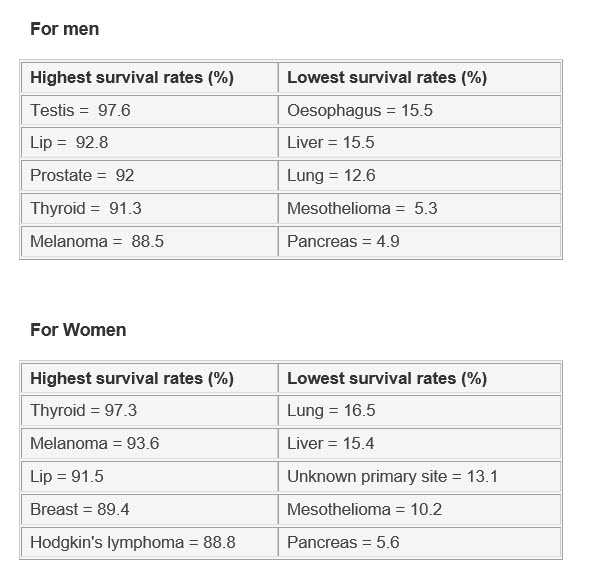Overall, cancer survival rates are increasing.
A report from the Australian Institute of Health and Welfare found that the cancers with the largest survival gains during the last 30 years are:
- Prostate cancer – which can be found by blood test and examination
- Kidney cancer – which can be found by imaging such as the V-Scan
- Non-Hodgkin lymphoma – which may be found during medical checkups
Cancers
Five-year relative survival rates (%) in Australia 2006-10
It is important to find cancers early, and to be treated by cancer specialists who are at the top of their game – which is why we only recommend the best, from our experience at Executive Medicine.
Lung cancer occurs overwhelmingly in smokers. We can screen for lung cancer with a lung CT scan.
Liver cancer may be diagnosed with imaging such as the V-Scan, in addition to a physical examination with blood testing.
Prostate cancer now kills about 3000 men a year. Survival rates have improved from 58% to 92%. Blood testing for PSA may have introduced some bias into this startling figure however.
Non-Hodgkin lymphoma
The report found survival rates had improved from 47% to 71% for non-Hodgkin lymphoma between the periods 1982-87 and 2006-10.
Kidney cancer
Survival rates for kidney cancer improved from 47% to 72% between the periods 1982-87 and 2006-10.
Breast cancer
For breast cancer, which makes up one-quarter of all cancer cases among women, the Australian Institute of Health and Welfare Report said five-year survival rose from 72% to 89% between 1982-87 and 2006-10.
Overall
One in two Australians will develop cancer before the age of 85. One in five will die from the disease.
Overall in the 25 years prior to 2007, the incidence of all cancers in Australia rose by 27% (which is likely due to better diagnosis) but deaths from the disease fell by 16%.
In our practice
In the past 10 years, only one of our regular patients died from a cancer. It was a melanoma and he had been a long-term patient of the high risk melanoma unit. Everyone else has done extremely well due to early diagnosis and treatment.
Many patients have had quite aggressive tumours picked up during their annual physical examination and subsequent testing. Due to early diagnosis and treatment they are essentially cured.
Early detection and prevention of disease. This is what we are all about.
To learn more ….
Sign up for our monthly newsletter

